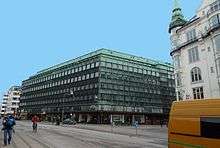Ole Falkentorp
Ole Falkentorp (18 February 1886 – 21 August 1948) was a Danish architect.
Early life and education
Ole Falkentorp was born into a family of architects on 18 February 1886 in Copenhagen. His father was Albert Jensen, architect, professor and Royal Building Inspector, and his mother Sophie Jensen née Nebelong, daughter of the architect Niels Sigfred Nebelong. He changed his name to Falkentorp in 1899.
He was enrolled at the Royal Danish Academy of Fine Arts, where Historicism still dominated and his father was a central figure, but left shortly after. Instead he took classes at a technical school and apprenticed as a mason.
He was then articled to Heinrich Wenck, head of the architectural office of the Danish State Railways. There he met Carl Petersen and Povl Baumann with whom he would later collaborate on several projects.
Falkentorp's architectural expression moved from Neoclassicism through Modernism to Functionalism.
Important works, all in Copenhagen, include the Classen Have housing development (1924, with Carl Petersen and Paul Baumann), the office building at the North Port (1930–32, together with Paul Baumann), the Ved Vesterport office building (1930–32, with Povl Baumann) and the Hotel Astoria (1935) next to Copenhagen Central Station.
In 1911, Falkentorp was a co-founder and dedicated debating member of Den Frie Arkitektforening, an alternative architecture association.[1]
Selected works

- Classens Have residential building (1924, with Carl Petersen and Povl Baumann)
- Ved Vesterport office building, Vesterbrogade, Copenhagen (1930–32, with Povl Baumann
- Hotel Astoria, Banegårdspladsen, Copenhagen (1934–35)
- Hornbæk Badehotel, Hornbæk (1934–35)
- Hotel Codan, Sankt Annæ Plads, Copenhagen (1948–50, with Ole Buhl and Harald Petersen)
References
- ↑ "Ole Falkentorp". Gyldendal. Retrieved 2011-04-12.